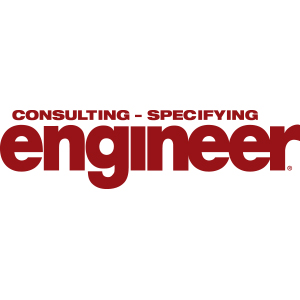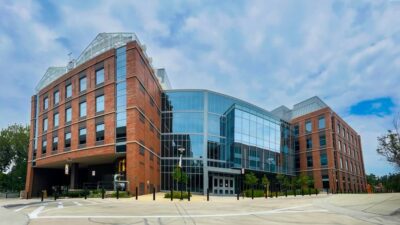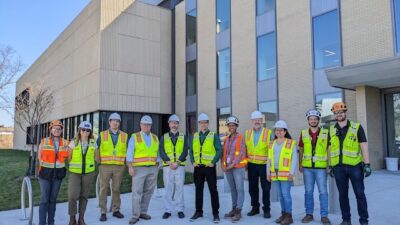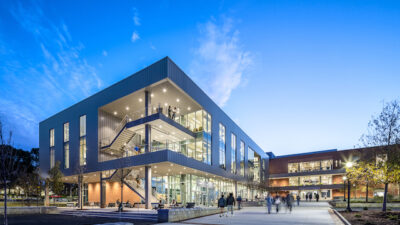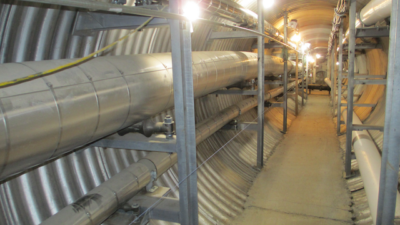Labs and research facilities house sensitive equipment and must maintain very rigid standards. Key areas include air quality, security, and flexibility. This provides a general overview.

Participants:
Nedzib Biberic, PE, LEED BD+C, Mechanical Engineer, PAE Consulting Engineers, Portland, Ore.
Michael Chow, PE, CxA, LEED AP BD+C, Member/Owner, Metro CD Engineering LLC, Powell, Ohio
David S. Crutchfield, PE, LEED AP, Division Manager, RMF Engineering, Baltimore
Dave Linamen, PE, LEED AP, CEM, Vice President, Stantec, Edmonton, Alberta
Jay Ramirez, Senior Vice President, ESD Global, Chicago
CSE: Please describe a recent lab project you’ve worked on—share problems you’ve encountered, how you’ve solved them, and aspects of the project you’re especially proud of.
David S. Crutchfield: We recently completed a new lab building that included a vivarium on the ground level, one level of offices, and three levels of labs. During the late stages of the design, the funding source dried up and the five-story building was completed with floor No. 1 being a completely built but unoccupied vivarium, floor No. 2 being an occupied office component, and the top three floors shelled for future wet labs. The air handling equipment was all purchased and installed with the initial construction. After the construction was completed, funding for the shelled floors was released. Unfortunately, during the lull in the construction, the program for the lab and vivarium changed. Our task became one in which we worked with the planners to determine how best to fit the changed program components into the core/shell design to ensure that the HVAC equipment bought in the initial construction would work with the new program. A lot of test fitting and re-test fitting was necessary and ultimately we were able to match the new program up with the capacity of the installed equipment.
Dave Linamen: We designed a new physical sciences building for a major university in New York, approximately 190,000 gross sq ft. The building houses research and teaching for chemistry and physics. There were four major chemistry labs, each with 11 6-ft fume hoods. There were also state-of-the-art physics labs with demanding vibration limitations. The building was bounded on three sides by existing buildings. There was one central shaft for all mechanical and electrical services that extended vertically in the building. Immediately beneath the penthouse, there were executive offices, so sound and vibration were of serious concern. The university monitors and manages energy closely for all buildings, so we knew our predictions for energy use would be compared to actual energy use.
First we developed a very sophisticated energy model that accurately represented all of the components of the building that contribute to energy use. We then completed a sensitivity analysis to determine which systems and components had the greatest influence on energy use, and how those systems and components actually affected the building energy use. The model confirmed what we already knew, that variable air volume (VAV) was the single strategy that resulted in the greatest energy savings from a cost/benefit perspective. The second most effective strategy was using a single system to serve labs, offices, and conference/lecture hall spaces. The next most effective strategy based on cost/benefit from energy savings was using occupancy sensors to expand the temperature control deadband when labs were unoccupied, which in a university environment was significant percentage of the time. The next most effective strategy was consciously designing the entire air handling system to minimize air pressure drop and, consequently, fan horsepower. We designed the single HVAC air system with one fully redundant air handling unit, but under normal (non-failure) conditions, all air handlers operate at reduced air volume, and hence, reduced velocity and pressure drop through filters and coils. Through the duct system, air velocities systematically step down from 1700 fpm in the risers to 1400 fpm in the horizontal mains to 1000 fpm in the branches to 500 fpm in diffuser necks. The horizontal mains are designed as extended plenums that reduce total air pressure drop and provide flexibility to accommodate high air demand anywhere in the duct system. Heat recovery was also provided to result in the lowest possible energy use.
The building was proven to be the most energy-efficient lab building among several that were recently built on the campus. Energy use is less than 200,000 Btu/sq ft/year, which is excellent performance for such an intense lab building, and the budget for the mechanical, electrical, and plumbing (MEP) systems was within the typical range for similar science buildings. The actual first year energy use recorded by the university was within 2% of the predicted energy use.
Jay Ramirez: ESD is completing/closing a confidential project with a budget of $270 million including site development, central utility plant, manufacturing, short-term storage, administrative offices, quality assurance/control product test laboratory, and owner provided equipment. The goal was a facility that meets market demand at competitive international market prices as well as a one-year project schedule and budget-mission accomplished. The lesson in this project was not so much the technical solution, but the conveyance of information and willingness to exchange and share design ideas, make timely decisions, and respect the opinions and intellectual experience of the entire design team (owner/designer/contractor). We changed the way we thought about project delivery. This project was a success because of the proactive and flexible exchange of ideas and communication.
CSE: What unique enclosures, cleanrooms, or other types of rooms have you worked on recently?
Ramirez: We recently completed a project that required a hydrogen peroxide emergency purge system. This was achieved by using oxygen sensors to measure levels and placing the HVAC system in full purge mode at predefined oxygen levels. Auxiliary exhaust fans, variable frequency drives, automated dampers, and sequence of operation purge modes were programmed into the system.
Linamen: Probably the most unique was a room for specialty physics where the criteria were extremely demanding. The room was in the lowest level of the building, and the floor was a thick concrete mat that was completely isolated from the surrounding floor. Only minimal ventilation air supply was permitted in the room to maintain air quality. Cooling and heating were from a radiant source.
CSE: What are some common missteps that engineers might make on a laboratory project?
Michael Chow: Cleaning up power should be considered as many laboratory instruments have sensitive power parameters. Consideration should be given also to using uninterruptible power supply (UPS) systems.
Crutchfield: We sometimes run into lab projects where the old 12 air changes per hour (ACH) rules are still being enforced by the environmental health and safety folks at the various institutions. Couple that with the desire for constant volume hoods, which seem to be favored by maintenance staff, and it’s a recipe for an underperforming building. When we discuss this with the owners and suggest alternate compliance and safety methods, they often recognize that there are better ways to accommodate lab airflows, but many owners are still reluctant to change from their institutionally set policies. We aren’t always able to convince them that alternate methods should be used for their projects, but we feel that it is our responsibility to show them the alternatives, and the economics of the alternatives, so that they can be more informed as owners. The goal is to help them ultimately understand their internal policy, and compare that to current state-of-the-art procedures, so that if they want to make policy changes, they have full understanding of the issues involved.
Ramirez: Design for flexibility in control strategies, input/output expandability, and provide for plenty of instrumentation. Laboratory users are constantly changing, particularly in R&D facilities. Specifying the proper control architecture for achieving functional changes a laboratory space may see over the course of its life, specifying proper material for application (metals, gasket seals, temperature and pressure scales, etc.) to achieve functional changes in the laboratory. Of course, this must be balanced with project budget.
Linamen: One common mistake is in thinking that offices, labs, and classrooms/lecture rooms in lab buildings all need to be served from separate HVAC systems. Segregating these spaces on separate systems requires added space for equipment and supply/return/exhaust risers. For a physical sciences building we worked in, there were sophisticated research and teaching labs, as well as classrooms/lecture halls and offices. There is one HVAC system for the entire building, and one main supply air riser, return air riser, and exhaust air riser. Laboratory air is 100% exhausted. What is frequently not recognized is that for most mixed-use lab buildings, the lab air requirement is usually a major part of the total HVAC air requirement for the entire building, usually 70% or more. If multiple HVAC systems are provided, a percentage of the return air from the offices and classroom spaces must be rejected, so that a corresponding percentage of ventilation air can be provided to maintain air quality. However, if one common HVAC system serves all spaces and if the lab air requirement is a high percentage of the total air requirement, 100% of the air from the offices and classroom spaces can be returned. This reduces the total air requirement for the building. This usually results in fewer air handling units for the building, so it saves first cost, it improves overall flexibility because labs can be converted to non-lab functions and vice versa without major changes to the HVAC, and the non-lab spaces have excellent air quality because they receive higher than normal percentage outside air. This usually makes it more convenient to provide redundancy, because redundancy is only required for the one system.
CSE: When working in labs outside the United States, what differences, challenges, or best practices have you observed?
Crutchfield: Our experience has confirmed that laboratory standards outside the U.S. have not evolved to the extent they have in the U.S. Standards outside of the U.S. have remained unchanged largely because the international markets have not developed as many new state-of-the-art lab facilities as we have in the U.S. Many of the criteria points such as load densities, air change rates, and fume hood face velocities have not been challenged because the need simply has not occurred. However, with the globalization of industry groups, this is beginning to change. In the European market, attention to overall health and safety within the lab environment requires focused risk assessment by the project team. The project team routinely consists of owners, design professionals, lab operators, and maintenance staff. We have found this refreshing, as clients now understand the critical role appropriate operating procedures serve for laboratory health and safety.
Ramirez: In the United States, it is general practice to assign about 25% of a fee to construction administration. This is generally in the standard design/bid/build project delivery model. Delivery of a similar project abroad is generally a design/assist or design/build delivery model. This will require significantly more on-site support, and commonly we can see the fee structure being more like 55% design and 45% construction administration and/or on-site support, if not an even split. Depending on the project schedule, this is probably the best way for design professionals to manage their risk.
CSE: What tools or knowledge do engineering schools need to provide young engineers in order to successfully specify systems in labs?
Linamen: This is editorializing, but engineering schools need to teach students how to think. They don’t need to teach more content. They need to teach students how to solve problems in a comprehensive way, utilizing all of the tools in their knowledge toolbox. When they get engaged in designing specific building types, the senior design team members can teach them about the critical aspects of lab design. It is not realistic to believe students can graduate from engineering school knowing how to design every building type. In their early years after graduation, they should look for the opportunities to design different types of buildings, and from those experiences, decide on which types of buildings they wish to specialize.
CSE: When designing a lab that is part of a multi-use building (such as in a hospital or university building), what unique challenges do you have?
Ramirez: In a fee-competitive environment the decision making process and end users requirement definition can cause design agencies financial harm and schedule impact. Being well prepared and offering solutions/options during early concept design and schematic design will help your clients “help you.” As healthcare and institutional design professionals, we know our business and can provide sound engineered solutions. We need to take a proactive role in the early stages of the project to help stay on schedule and on budget and assure the client is making sounds choices for its facility.
Crutchfield: We have found that independent zoning, the access control, and security levels increase in multi-use labs. With many research labs operating beyond the typical 9 a.m. to 5 p.m. office hours, designing the systems such that the labs can stay operational while the non-lab areas are set back allows for flexibility in the operation of the building, which often leads to energy efficiencies. The labs are designed for continuous operation and the multi-use areas for noncontinuous operation. A second issue that we deal with on many higher education labs is the need to hide the fact that the lab is there to reduce the potential for vandalism or protests. Nothing broadcasts “lab” like a set of Strobic fans on top of a building. Integrating the exhaust systems into the building architecture so that they are hidden can alleviate some of those concerns.
Linamen: Something else we have learned from university labs is that they are very frequently unoccupied. Our studies have shown they are unoccupied as much as 60% of the normal daytime hours. We use occupancy sensors to not only reduce lighting levels where it does not cause safety issues, but we also use the occupancy sensors to expand the thermostat deadband when the spaces are unoccupied. We let it expand +/-3 F during daytime hours and +/- 6 F during nighttime hours. This saves reheat energy in labs that are dominated by exhaust airflow and saves cooling and fan energy in labs that are dominated by internal heat gain. We have found this energy savings to be significant over an entire year, and the cost of the occupancy sensors is very low in the overall scheme of things. Because of the typical high airflow rates for labs, recovery from the setback is usually very quick if the lab suddenly becomes occupied.
Another mistake designers make is designing the mechanical, electrical, and plumbing (MEP) infrastructure strictly to serve the initial intended use of the building. We should be thinking in terms of 40- to 50-year life when designing the building infrastructure, and research and science done in lab buildings will evolve significantly over that time period. Lab building MEP infrastructure should be designed with this in mind.
CSE: Describe your involvement in a recent integrated project delivery (IPD) lab or research facility.
Linamen: We have a very large lab project that is currently being completed utilizing an IPD process. It has been a true learning experience. I honestly believe IPD is the future, but it will take some time for owners, designers, and builders to perfect the process. The biggest challenge is in understanding how the other team members function and then determining how our industry can be a valuable partner in the collective process. Communication is key. Our design team had to work collaboratively with the construction team at the project site for several months to really get the barriers to communication completely eliminated. Some team members just couldn’t adjust to the new way of doing business, and they had to be replaced. This all took time. If we could do the same project with the same people again, we could probably cut the time in half. Because the relationships are so important in IPD, it may become advantageous to form key alliances between designers and builders in order to pursue work.
Crutchfield: We’ve found that IPD has lessened the owner’s exposure to costly changes on complex lab renovation projects. Being able to share our design concepts with the folks who are responsible for phasing and scheduling lets us design systems that function, while allowing the contractor team the level of comfort with us to be able to suggest alternatives without the specter of a change order. We’ve also found that when the contractor can procure, and we can coordinate with, the actual lab equipment being provided early in the design, we avoid over-designing systems to accommodate a range of potential equipment.
CSE: In specialty facilities, like vivariums, what issues have you come across?
Linamen: Security requirements for vivariums are more critical than for most labs or other building types. Often, animal holding rooms house animals from several researchers. They each want to make sure access to the spaces is limited to only those people who are authorized, and they like to know how often and by whom the rooms are being accessed.
Crutchfield: The requirement to keep the animals within the owner- or Association for Assessment and Accreditation of Laboratory Animal International designated temperature/humidity/lighting levels is always a primary concern with vivariums and is animal specific. Providing an appropriate and cost-effective level of redundancy and reliability for these spaces while maintaining an appropriate first cost can be a challenge. We often seek cost-effective ways to gain reliability and redundancy for the vivarium by connecting the vivarium HVAC systems to adjacent lab HVAC systems for emergency backup. In the event of a loss of primary vivarium HVAC equipment, the backup is not a dedicated standby system, but rather a backup that relies on the excess capacity in the lab systems. We strive to find novel opportunities to keep costs down while maintaining proper levels of redundancy and reliability, and not simply relying on adding standby systems.
